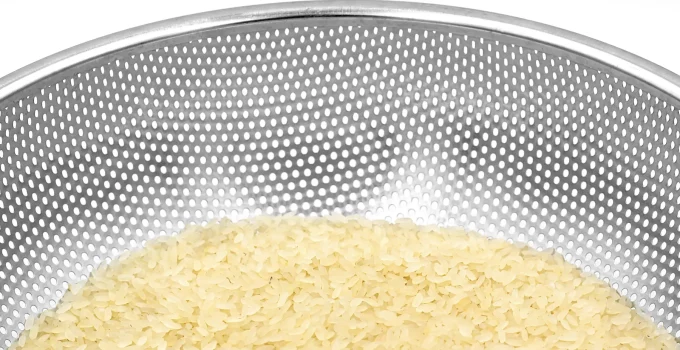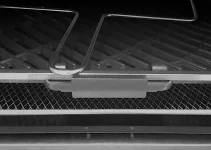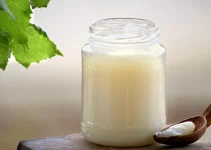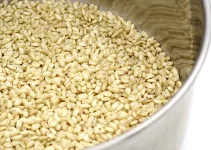It’s going to be amazing to talk about my top recommendations for the best rice washer or rice rinser.
Maybe some of you are dreading this part of the cooking process but I actually like it a lot. I frankly love the part where I get to go through the rice grains with my hand and massage them gently until the water runs nearly clear.
Well, I guess I’m weird like that. After all, I also get really excited when talking about air fryer + grill combos or when looking for cooling racks. And even when looking for camping kettles.
I just love everything that relates to cooking from selecting ingredients, perfecting cooking methods to choosing amazing kitchen tools and appliances, like this situation right now where we’re looking for the best rice washer or a rice rinser.
Whether we’re cooking our rice on the stovetop in a pan or we’re using a rice cooker to do the cooking for us while we go and do other things or just simply take the time to relax, we simply cannot skip washing those grains.
Maybe using a rice rinser would make it all easy and effortless. I hope it will give you the motivation you need.
And we really don’t have to spend a good deal of money when we’re shopping for the best rice washer, which is nice.
It’s basically a bowl with some tiny holes to drain the water without also losing some of our grains. That always happens when we’re washing our grains in a regular bowl with no tiny holes in sight.
If we’re using a regular bowl or a pan, whenever we throw the water out we also lose a few grains. And we have to wash our rice about 3-4-5 times. With all that washing we can lose a good deal of grains. That’s the main problem with using regular bowls. But a rice rinser can make things easier.
Table of Contents
Best Rice Washer Reviews
I’ve written reviews for the best ceramic rice cookers and the best stainless steel rice cookers.
Whenever it came to the part where I talked about how to use these wonderful appliances, I always mentioned that we have to wash the rice first.
We don’t have to wash the rice if we’re making risotto, that’s an exception because we need the starch for the creamy texture.
Zojirushi teaches us exactly how we should wash our rice. Well, it’s a simple process and I never skip it so it’s great to look for the best rice washer.
Thus, those who want to make things easier for themselves will love looking for amazing rice rinsers that cost about $10-$15-$20 so we won’t spend much for a bit of comfort.
A washer for rice is basically a strainer, a colander as it’s mostly called. They can be made of metal (stainless steel) or plastic and they have tiny holes so the water flows freely as we wash the grains but no grains go down the drain.
We can also use a fine-mesh strainer if we don’t want to buy a special rice rinser.
1. OXO Good Grips Rice & Small Grain Washing Colander: Overall the Best Rice Washer
While the OXO Good Grips Rice & Small Grain Washing Colander is not the cheapest pick as the best rice washer, it’s definitely quite amazing. I personally believe it’s worth the price because I see it lasting for a lifetime even. And OXO kitchen tools are among my favorites.
It is described as being ideal for rice, quinoa, buckwheat, and barley. Those grains are all delicious so I’m definitely loving this colander.
However, what I love the most is the design. Well, the colander is pretty classic looking. From a distance, it looks similarly to a normal, nicely sized white, plastic bowl.
But there’s one thing that makes it stand out and that makes it look so nice and quite beautiful.
The handles transform this colander from a simple plastic bowl to one that looks so nice and easy to use. It can definitely fit any kitchen design.
While stainless steel colanders and fine-mesh strainers can be amazing, a product like the OXO Good Grips Rice & Small Grain Washing Colander looks so nice.
Features
It is designed to allow water to strain at the ideal rate to wash impurities and starch from rice, quinoa, buckwheat, barley, and more.
The design is quite ingenious.
We get holes both on the bottom and on one of the walls, and I can totally see why this arrangement of holes on two different sides can work quite well.
When we wash our grains under cold water, the holes on the bottom are slow draining. That allows us to wash our grains thoroughly. Also, the water pools on the bottom so we can see when the water is clear and we can stop washing.
Next, on the wall we have a pour spout that features extra drain holes to remove excess water.
Once we get rid of all the water, shake the colander a bit to remove even more water.
The soft, comfortable, non-slip handles make it easy to shake out extra water, agitate the grains, and pour the grains into our rice cooker or pans.
Of course, we can also use this strainer to rinse berries, which is also a nice use of it.
All in all, the OXO Good Grips Rice & Small Grain Washing Colander is a well-designed product, a top pick for the best rice washer, even if the price is a bit high. It still costs under $20 so that’s not too bad. There’s no wonder that it’s so incredibly popular and so highly rated.
2. Paoli Stainless Steel Microporous Colander: Best Stainless Steel Rice Washer
While the Paoli Stainless Steel Microporous Colander is not exactly cheap, costing between approx. $20 and $35, there are a couple of important things that justify the price.
While the OXO Good Grips Rice & Small Grain Washing Colander is more my style, there are some people who might have different preferences.
Basically, this Paoli Stainless Steel Microporous Colander is great for those who are only looking for stainless steel colanders when they’re shopping for the best rice washer.
Another factor that justifies the higher price is the fact that this is actually a set consisting of two pieces. Let’s learn more.
Features
We get 2 pieces and they’re both made of 304 stainless steel, which is great. It is described as being safe, healthy, and durable and I totally agree. After all, there are also stainless steel rice cookers, which are very good.
Thus, we get two pieces: a colander and a mixing bowl.
The colander is described as being microporous because it has tiny pores, holes with a 2 mm diameter.
It is suitable for cleaning most grain varieties. The holes are uniform. That will quickly drain the water and we can wash a big quantity of grains.
The mixing bowl is basically a regular stainless steel bowl.
Another thing that I really like is that we get to choose from different sizes: 1.5 qt, 2 qt, 3.5 qt, and 5 qt.
I’m glad that we can choose between these different sizes because each of us will have different needs.
If you want to use a very big colander and a really big mixing bowl, then choose the 5 quart set.
Both the bowl and the colander measure 11.8 inches in diameter and 4.72 inches high.
3. Inomata Plastic Japanese Rice Washing Bowl with Strainer
A highly popular rice rinser is the Inomata Plastic Japanese Rice Washing Bowl with Strainer.
Plus, once we read the word Japanese, most of us are intrigued and want to know more.
I think I even read somewhere that it was described as being a game changer and magical. And that it was the secret to fluffy, perfectly cooked rice.
I’ll be honest: I’m only going to call a colander magical if it actually washes the rice with no input from me or my hands. So, yeah, no matter how awesome a rice rinser is, I’m not calling it magical or a game changer.
I mean, I absolutely agree that shopping for the best rice washer can make things so much easier and it can eliminate any potential for wasted grains but that’s as far as I’m going to go with my praise for these nice kitchen tools.
After all, we can use a fine-mesh strainer if we don’t own one of these colanders so it’s not like they don’t have any easy-to-find substitutes.
Regarding the fact that the Inomata Plastic Japanese Rice Washing Bowl with Strainer is the secret to fluffy, perfectly cooked rice, I would actually insist on saying that rice washing is one of the secrets but a certain colander is not the secret. Of course, getting our rice : water ratio right is also extremely important. As is using good quality grains, etc. There’s a whole process.
Features
What I must say that I thoroughly like about the Inomata Plastic Japanese Rice Washing Bowl with Strainer is the price.
For a price under $10, we can buy either the 2 quart or the 2.5 quart size.
While the sizes are not the biggest, they’re more than good enough for most of us.
We can even buy them as a set, paying a cheap price for both the 2 quart and the 2.5 quart sizes.
That’s a good deal and they’ve certainly won me over with those affordable price options.
The design is very nice, very interesting.
The bottom doesn’t have holes. It’s a solid bottom so we can wash our rice until the water is clear.
For draining the water we get a side drain. Thus, we can also use this colander for soaking grains and then we can drain them though the side drain. I like this option a lot.
The manufacturer mentions that a thorough washing can significantly reduce toxins and chemical levels. Yet another reason to take our rice washing seriously and try not to skip it ever again.
It’s great for absolutely all sorts of grains, fruits and veggies.
The Inomata Plastic Japanese Rice Washing Bowl with Strainer is made in Japan from BPA-free, food-grade plastic.
It is top-rack dishwasher safe.
4. Kotobuki Japanese Rice Washer with Dual Drain
Since we’re on a roll, let’s review another Japanese product for our rice washing needs.
It’s another affordable colander with a nice, clean design. The design definitely doesn’t stand out in any way but I still like it.
Plus, the price around $10 or a bit under is definitely a big plus. As we saw, we’re going to have to spend significantly more if we are only looking for stainless steel colanders.
Features
This time, the Kotobuki Japanese Rice Washer with Dual Drain has a quite similar construction to the OXO Good Grips Rice & Small Grain Washing Colander in respect to the dual drains.
However, the OXO one is almost two times more expensive so you might prefer this cheaper version.
The strainers on the bottom and on the side assure thoroughly drained rice.
Of course, it also works for other grains and for rinsing fruits and vegetables.
It’s made in Japan and it’s easy to clean, wash it by hand.
5. Bellemain Micro-perforated Stainless Steel Colander
When we think of a classic, stainless steel colander, I guess this would be what we’re thinking of.
It’s a total classic stainless steel colander with fine holes, thus the name micro-perforated.
I love the whole design.
What I love the most is the base of this colander. That solid stainless steel base looks really amazing and it allows us to place it on the bottom of our skin, on countertops or on tables.
I like that we can place it on the bottom of the sink and wash the rice as cold water flows. And we can use both our hands to speed up the process.
Overall, the Bellemain Micro-perforated Stainless Steel Colander is seriously one of my top favorites. It’s a top pick for the best rice washer and for so much more.
Plus, we can also use it to drain pasta, noodles, and any other hot dishes, which is a plus. We can’t do that with plastic colanders.
The base and the stainless steel make the Bellemain Micro-perforated Stainless Steel Colander highly versatile.
Rice and spaghetti won’t fall through the holes. Plus, I’m not the biggest fan of mesh colanders.
But these ones with micro pores are very easy to clean.
This one is also dishwasher safe if you don’t want to quickly wash it by hand.
Features
There are 2 sizes to choose from: 3 quart and 5 quart.
If you’re cooking big meals or you frequently wash a lot of fruits and veggies, the 5 quart can be more suitable. It’s also quite expensive but it can be worth it because it’s high quality.
The 3 quart size is great for smaller families or for single people.
Both sizes come with quick draining micro-perforations. The tiny, closely spaced holes mean that our food drains fast without having to tilt the bowl.
Plus, the stable draining ring base won’t tip over. I love this base.
The two sturdy handles are amazing, as well. It’s easy to carry this colander around even when it’s piled high.
It is made of rust-proof, dishwasher safe 18/10 stainless steel.
What happens if we don’t rinse rice?
We wash our rice not because it’s necessarily dirty because nowadays produced grains are certainly amazingly clean.
We actually go through this process because we want to eliminate residual starch.
If we cook our grains with all that starch on them, then the grains can be very sticky once the rice is done cooking. We don’t want sticky rice unless we’re actually making sticky rice and that’s a totally different texture from grains that get sticky because of all that extra starch.
If we don’t rinse our grains, the rice will end up cooking as a not very pleasant risotto instead of being fluffy and each individual grain being properly cooked without sticking in a clump.
The texture of our cooked rice is just as important as the texture for cooked pasta or noodles.
Overcooked pasta is just as bad as eating rice that is sticky and clumpy and all wrong. I really don’t know which would be worse.
It’s supposed to be fluffy just like pasta needs to be boiled al dente. These textures greatly influence how we enjoy our dishes. And an off texture can ruin the other ingredients no matter how delicious they are.
How to wash rice properly using the best rice washer
Zojirushi describes washing rice as one of their secrets for delicious rice, which totally underlines just how important this step is.
Step 1. Be gentle
Today’s rice is definitely cleaner thanks to improved milling methods so that’s why some people might choose not to wash the grains at all.
While it is true that it’s cleaner, it’s also more sensitive to scrubbing and soaking.
So, the first step is to be gentle when we massage the grains in the water with our hand.
Don’t rub the grains together too harshly because that can break the grains.
As soon as the water becomes dirty, we throw it out and fill in our bowl or pot with clean water.
However, if we’re using a rice washer we don’t have to throw out any water because we have tiny holes that let the water flow freely.
Step 2. Be quick
Another thing we must keep in mind is that we must be quick.
Today’s grains can absorb water quickly and we don’t want that because we’re using precise rice : water ratios when we’re cooking our grains. If we want them fluffy and not watery, we must avoid grains from absorbing too much water during washing.
Just keep the rice washer under cold running water for 30 seconds up to a minute, gently massage through the grains with your hand, let it drain off the excess water for a bit and then you’re done and you’re ready for cooking.
In their guide, Zojirushi mentions completing a 4 step guide about washing rice within 10 minutes.
But I certainly recommend taking just a minute under cold water to wash your rice in a rice rinser.
I don’t have the patience for more but you can take a lot longer if you have the patience for it.
Even if Zojirushi doesn’t mention using a rice washer because they’re advertising their rice cookers so they’re using the inner pot from their appliance to wash rice, I still totally agree with their guide.
The difference is that some of us know that looking for the best rice washer can make the process even easier and we can avoid throwing grains down the drain as we drain the water, which is totally the purpose of looking for a rice rinser.
Best rice washer FAQs
Let’s answer a few frequently asked questions that relate to our quest of looking for the best rice washer.
1. How do you wash rice without wasting water?
In my opinion, the easiest and quickest way to wash rice grains is to use a rice washer like the OXO Good Grips Rice & Small Grain Washing Colander, the Inomata Rice Washing Bowl or the Kotobuki Japanese Rice Washer with Dual Drain. If you don’t want to waste water, be quick, a bit more forceful in running your hands quickly through the grains, and move your hands rapidly and efficiently under running water for 30 seconds up to a minute. That should be enough.
2. Does washing rice remove nutrients?
Personally, I don’t truly care about this aspect because we either have to wash certain rice grains or we cook certain rice grains without washing them. That’s the truth and I don’t care that washing rice might remove nutrients when it simply has to be done if we want to cook a fluffy, delicious rice. Basically, rice that is cooked by the absorption method, either in a rice cooker or in a pot on the stovetop, needs to be washed. This is the rice we use to make fried rice, pilafs, salads, kimbap, and even sushi. Rinsing the grains will prevent them from getting unpleasantly mushy. Rice that is used to make risotto or paella, where the starch is needed and welcomes, doesn’t need to be rinsed.
3. Is washing rice still necessary?
As I’ve mentioned above, there are only a few exceptions that don’t need to be washed, like when we make risotto or paella. In general, we need to wash rice and I’m not saying that just because I’m here reviewing the best rice washers. We need to wash grains to remove excess starch. That’s how we cook delicious rice that has a fluffy texture with separate rice kernels. Otherwise, we’ll be cooking unpleasantly mushy rice and no one likes that. Washing rice is an integral part of the whole cooking process.
4. What bowl to wash rice in?
As we saw in our guide looking for the best rice washer, there are special colanders or bowls that are specifically designed for this task, like the OXO Good Grips Rice & Small Grain Washing Colander, the Inomata Rice Washing Bowl or the Kotobuki Japanese Rice Washer with Dual Drain.




